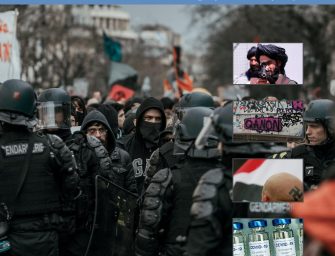#ReaCT2021 – The terror threat in the UK
by Raffaello Pantucci, RSIS-NTU, Singapore and ReaCT
The  complexity of the terror threat picture faced by the UK was recently highlighted through three separate cases; two of the infamous ISIS Beatles finally made a court appearance; two converts were jailed for trying to launch a terror attack in prison, and a case against a teenager accused of self-radicalising during the past spring lockdown, whose proceedings have failed. Taken together these show the complicated persistence of the violent Islamist terror threat that the UK faces.
complexity of the terror threat picture faced by the UK was recently highlighted through three separate cases; two of the infamous ISIS Beatles finally made a court appearance; two converts were jailed for trying to launch a terror attack in prison, and a case against a teenager accused of self-radicalising during the past spring lockdown, whose proceedings have failed. Taken together these show the complicated persistence of the violent Islamist terror threat that the UK faces.
The persistence is visible in the cases of ISIS Beatles and the attempted prison attack. Alexandra Kotey and Elshafee Elsheikh were longstanding figures of concern to the security services. Involved in a West London network that has long fed young British men to jihadi battlefields and created terrorist cells back in the UK. They left for Syria in 2012 to fight alongside Jabhat al Nusrah. Once out there, they joined ISIS and now are standing trial for their crimes.
The prison attack was led by Brutschom Ziamani, a convert who was jailed in 2014 for his plan to attack a soldier emulating his hero Michael Adebolajo who had murdered off-duty soldier Lee Rigby outside his barracks in 2013. Both Michael and Brutschom were part of the al Muhajiroun community, a group that has been a cradle to numerous terrorist plots and networks across Europe. Having been jailed, Brutschom lost none of his vigour and repeatedly refused to engage with rehabilitation programmes instead choosing to seek to radicalize his fellow prisoners. One of them, Baz Hockton, was persuaded to join him on a desperate suicide mission to kill prison guards and die in the act. They failed and now face further life sentences.
There is little chance that any of these men will repent their views at this stage
Given their relative youth, this means the UK system is going to be managing them for the next few decades. While Kotey and Elsheikh are not sitting in UK prisons, they are emblematic of a network that fostered dozens of young radicals who are scattered to the winds. Many of these are committed fighters who will require attention and remain of concern for years to come.
These cases illustrate the way that old problems seem to never go away, but keep popping up again
On the other side of the coin, on 9th October 2020 a court in London cleared a 14 year old boy whom authorities claimed had radicalised during lockdown with too much time on his hands. Having discovered extremist ideas, he followed them down the rabbit hole and was accused of trying to plan to make bombs. He was arrested, charged and ultimately cleared by a jury. Whether he will be re-tried or not is unclear, but this was the second time in a month that the British authorities had faced the problem of a prosecution failing.
Clearly the justice system presumes innocence until proven guilty, but the fact that the security services expended so much energy and effort on these cases (the earlier case was of two cousins accused of building drones to use in terrorist attacks) suggests that they thought something was afoot. Yet, ultimately they were unable to prove the case. Part of the problem is that the cases that are now emerging are so disconnected from terrorist networks, are planning such random acts and the tools of terrorism are becoming so banal that it has become almost impossible to entirely shield yourself from the threat. But it has also become almost impossible to prove who might be going in this direction.
What cases we have seen in the UK over the past few years have for the most part involved individuals using knives, cars and other quotidian tools. They may be active talking to extremists or on extremist chat groups, but so are many other people and the conversations are fragmentary and intent is always unclear.
This is creating a new generation of radicals that authorities struggle to identify, define, arrest and convict
The danger is the fusion of persistence and complexity. On the assumption that some of these new confused cases are actual threats and will operate on timelines similar to earlier generations, the danger is a confusing threat which will linger decades into the future. Disconnected from known networks, but entranced by their ideas, they are likely to roam online communities occasionally turning to violence.
This helps capture the challenging threat that is faced. It is persistent in that individuals do not seem to give up ideas and continue to stay involved for decades.
And it is complicated in that it is almost impossible to easily isolate and identify the threats. Sadly, the terror threat is unlikely to pass any time soon. It is in fact likely to only complexify and confuse us further.
DOWNLOAD FULL REPORT (ITA/ENG)























